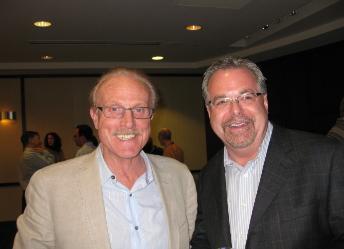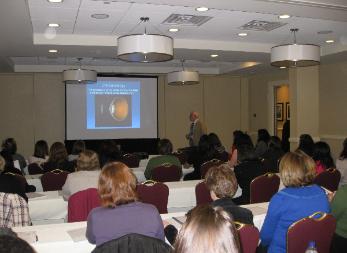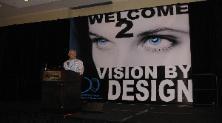
| Corneal Reshaping at the OAA meeting Vision by Design 2010 October 20-24 The Orthokeratology Academy of America held its fifth annual education meeting Vision By Design 2010 in Chicago Oak Brook (Illinois USA) from October 20-24. More than 250 attendees participated in the four-and-one-half day event that was highlighted by 14 workshops, six manufacturers’ seminars and more than 30 hours of topics and discussions in the field of corneal reshaping. Wednesday The first day of the meeting was a day of contrasts. Several sessions of the “Boot Camp” for beginners were held for doctors and staff alike. More than 100 attendees were treated to structured classes directed toward the novice or inexperienced practitioner to corneal reshaping. At the same time, fellow candidates were completing their last steps on the path to fellowship. The doctor boot camp attendees began their day with an instructive presentation (Ortho-K 100) from Richard Anderson explaining the mechanisms of corneal reshaping. His presentation was followed by Ortho-K 101, in which Basil Bloom went over the characteristics of the corneal reshaping lens. More than 250 attendees participated in the four-and-one-half day event that was highlighted by 14 workshops, six manufacturers’ seminars and more than 30 hours of topics and discussions in the field of corneal reshaping. These presentations were followed by an insightful presentation from Monica Allison with insightful lessons about good and bad candidates for corneal reshaping. Caroline Cauchi then discussed the bare basic essentials needed in a beginning corneal reshaping practice. Cornel LeBlanc covered how to present corneal reshaping as an option to your patients, offering many different approaches to the topic at hand. Caroline Cauchi presented contracts using real life practice examples that held much important content. Nick Despotidis next gave an inspiring talk about the how to integrate corneal reshaping into your practice. The session ended with an interactive Video Wet Lab by Caroline Cauchi illustrating many basic cases and fitting styles with illustrative fitting examples. While the doctor sessions were taking place, their staff were educated by the same presenters on how the corneal reshaping lens is different from other contacts and how it works. Bringing her vast experience in working with Nick Despotidis with EyeCare Professionals, Brienne Alfano covered a wide variety of topics including patient handling, instruction and management. The extensive education was brought to a successful completion with an open forum of presenters answering questions from both doctors and staff. Thursday Workshops were the theme of the second day, with a rotating format to begin the sessions. More than 150 eyecare professionals attended the workshops. The morning sessions included Euclid, Paragon, Wave and Ortho Tools. These featured one-hour presentations of which the doctors could attend three of the four. The afternoon sessions included a wide variety of presentations including a hands on Wave Computer Lab, The Dual Axis design and Global Orthokeratology Vision (GOV) with live corneal reshaping patient fits including for hyperopia and progressive molding. Two additional workshops featured Advanced Wave with Ken Maller and OrthoTools presented by Patrick Caroline and Eddie Chow. Friday Friday’s vendor seminars included a look at the latest developments in corneal research by Euclid and a Wave Q&A by Jim Edwards. Friday also saw the beginning of the general sessions, which Nick Despotidis kicked off with a spirited discussion to fire up the attendees. Patrick Caroline began the formal sessions by covering new approaches to fitting the astigmatic eye with corneal reshaping and closed with an exciting look ahead to customized corneal reshaping. The GOV presentation covered all aspects of current corneal reshaping fitting and took a look ahead as to what may be possible in the future. The presenters were Charl Laas and Chris Eksteen, who effectively shared their expertise in corneal reshaping fitting with the audience. This popular method of using dual presenters became a common theme at the meeting and led to much spirited discussion between the presenters and the audience. The optimum lens design was a captivating presentation by Bill Berke, who used his research to argue for more than epithelial changes in corneal reshaping – he constructed a “phantom” corneal reshaping design created by the tear film to correct the refractive state. Peter Wilcox and David Bartels highlighted another aspect of corneal reshaping: that of rehabilitating damaged corneas with the use of scleral lens designs. The late afternoon sessions covered such topics as social media, a Smart Study Update given by Rob Gerowitz, topography analysis by Sami El Hage and hyperopic corneal reshaping by Steve Ernst, an area of corneal reshaping that is proving both safe and effective. The afternoon sessions would not have been complete without a dissertation on troubleshooting corneal reshaping fits with Tom Reim. John Abdella and Nick Despotidis teamed up for an exciting practice management presentation illustrating the effectiveness of internal marketing to grow your corneal reshaping practice. The session was brought to a close with a landmark teleconference with Helen Swarbrick from Australia. ‘The session was brought to a close with a landmark teleconference with Helen Swarbrick from Australia.’ Helen described her latest research in myopia control, which will soon be published. Attendees who wanted to take in Nick Despotidis’ “Power Workshop,” which was available after the general session ended, were not disappointed but may have been a little short on sleep as Nick gave them a plethora of pearls with great practice management ideas and motivational speeches that lasted to the midnight hour. Saturday The Saturday session started with Jeff Walline giving attendees his insights into fitting kids with corneal reshaping lenses. Jeff showed just how effectively children adapt to contact lenses and corneal reshaping in particular. Patrick Caroline went into the optics behind corneal reshaping and how the new research is pointing toward developing the most effective treatment effect. Patrick also covered new designs in glasses and soft contact lenses that may also retard axial elongation of the eye. The session at that point divided up in two groups. Randy Kojima gave a topography presentation that offered new focus to the different uses of corneal maps in corneal reshaping. In another session, Ken Maller described the many uses of the Wave software platform. Continuing the theme of dual presenters, Cary Herzberg and Nitesh Barot presented The Magic of Orthokeratology, covering many conventional and unconventional aspects of corneal treatment. Nitesh Barot presented cases that showed how corneal reshaping can correct high myopia and keratoconus. Myopia control was the theme of the afternoon sessions. Earl Smith, one of the leading researchers in the field, gave the first lecture. He demonstrated how myopia develops due to the peripheral retina and gave the audience a glimpse into some future technologies that may more effectively treat it. Dr. Tung next covered the topic of treating high myopia and showed just how safe new designs and technology have made this growing part of corneal reshaping. A presentation by Sami El Hage illustrated the present uses of cross-linking and perhaps a corneal reshaping application. Richard Anderson described how myopic development has been perceived over the centuries and why some new theories on its causes are rooted in our past. The session concluded with a special presentation by Ken Maller and Barbara Berney on post- lasik complications. The discussion arose from Ms. Berney’s personal experience with Lasik complications and her journey to discover like-minded eyecare providers who could help these patients. Awards The Banquet dinner that followed saw Research fellowships awarded to Patrick Caroline and Earl Smith for their research contributions to the field of corneal reshaping. Patrick Caroline also received the Outstanding Achievement in Orthokeratology Award for all of his many contributions to the field of corneal reshaping over the last decade. Sunday The Sunday wrap up day saw no pause in the quality and content of the presentations. The Eye- Q-Test was an interactive wonder! Given by Patrick Caroline and Randy Kojima, it covered all types of fitting issues with corneal reshaping patients, with the audience fully involved through an interactive device that recorded their answers. This session proved so effective that it will be carried over to our next educational event and perhaps used as a teaching module for practitioners active in corneal reshaping. The closing session was a presentation by Peter Wilcox and David Bartels on their very personalized “Candy” marketing program with examples and lots of marketing tools. The session closed with a presenter forum and, staying true to form, went well beyond the time allocated with great questions and comments coming from both the audience and the presenters. |



The next ‘Vision by Design’ meeting will be in Orlando, Florida, April 29 through May 1st, 2011. See this link for more information, registration and hotel information. |
